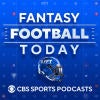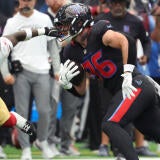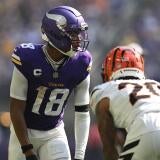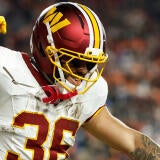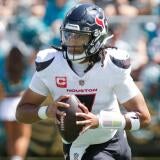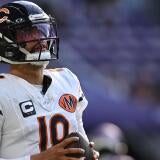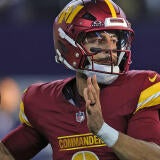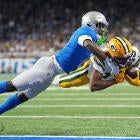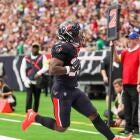Stealing Signals: NFC West 2019 recap, what to expect heading toward 2020
Ben Gretch reviews the 2019 season for each team from the NFC West.
With the 2019 regular season in the books, I'll be going division by division to share my initial offseason takeaways from each team.
This is mostly postseason note-taking as I emphasize what stands out most from the Stealing Signals column in 2019. We have an entire offseason of coaching and personnel changes plus additional research to break down what our 2020 Fantasy expectations will be, but I intend to refer back to these pieces as a barometer of sorts.
Arizona Cardinals
Snap Notes: Kenyan Drake — 79% average in eight games; David Johnson — 77% average through Week 6, 23% average after; Team — a lot of 4WR sets without TE early in year, had shifted to a lot of 2TE looks in certain games later in year
Key Stat: Team — 1,000 total plays (98-play increase over 2018, but 22nd in the league in 2019)
The big offseason hope for Arizona's offense centered on the speed at which Kliff Kingsbury's offenses played in college. Could this team go from 31st in total plays in 2018 to a top-five figure in 2019?
It turned out, no. Arizona played faster-paced but slowed down as the season went on, especially after Kenyan Drake became a focal point of the offense. And while the Cardinals added nearly 100 total plays to their 2018 total, they were still comfortably in the bottom half of the league in terms of overall play volume.
One big factor in play volume is the efficiency of the offense, as you have to be able to sustain drives. Arizona was middle of the pack in yards per play despite tying for the fifth-most sacks taken, and that bodes well for its overall volume going forward if the defense improves. Its defense gave up the second-most plays in the league, so Arizona's games weren't snooze-fests overall. It just wasn't a very good as a team, and opposing teams out-gained the Cardinals by more than 60 yards per game.
Drake was a workhorse and a star in the Fantasy playoffs. David Johnson essentially got benched. He was active but played just three snaps in Week 7, as Chase Edmonds handled a huge workload and rushed for three scores. It was attributed to injury, but after Edmonds got hurt the team acquired Kenyan Drake, and from the start of that Week 7 game on Johnson played just 104 snaps (14.9 per game) across seven games the rest of the season. By comparison, he had played more than 50 snaps in five of the season's first six games.
A big reason Johnson was a first-round pick in many leagues was his receiving potential and the potential of the lead back role on what projected to be a faster-paced offense with a quarterback running threat. Drake showed off the value of that role late in the season, and it will likely continue to be a valuable role going forward. It seems unlikely Johnson will be back with Arizona, and while there's hope for a rebound in value on a new team, he turned 28 in December and is several years removed from his best seasons.
Kyler Murray had a successful rookie season, and provided solid rushing value as expected. He failed to throw a touchdown in five of his first eight starts, and his passing touchdown rate was poor overall, but it improved substantially in the season's second half. His stat line has room to grow in almost all areas, and yet he was a top-10 quarterback in most formats. He'll be a popular and deserving breakout pick in 2020 drafts.
Larry Fitzgerald had a solid veteran season, but he isn't the player he once was. He has said he'll return for 2020, but he'll be a late-round pick without much upside at this stage of his career. Christian Kirk was the other main receiving weapon, and while his season was marred by injury, his efficiency was much worse than an impressive rookie season. I like Kirk to bounce back, but there's probably cause for concern.
There's also reason to be concerned about the three rookie receivers, none of whom did much. The Cardinals presumably hope at least one can take a Year 2 step forward.
Signal: Kyler Murray — solid first season, showed off clear path to future Fantasy upside; Kenyan Drake — late-season workhorse
Noise: Christian Kirk/David Johnson — hard to know how much injuries impacted their efficiency, but I'm more optimistic about Kirk going forward
Los Angeles Rams
Snap Notes: Todd Gurley — 75% average, played 15 games; Team — less 11 personnel later in year, more 2TE sets
Key Stat: Tyler Higbee — 92% average snap share over final five games (11.2 targets, 8.6 receptions, 104.4 yards per game in span)
The first half of the Rams season featured a lot of discussion about how the Patriots figured them out in Super Bowl LIII, and the Rams seemed to acknowledge that to a degree, shifting their personnel usage after the bye to feature the TE position more.
My read on the increase in two-TE sets is the Rams' depleted offensive line after the 2019 offseason needed help (something that almost certainly also impacted the similar Cardinals' shift). Tyler Higbee closed the season with a huge final five games, and he will be one of the more difficult players to value in 2020. Gerald Everett was injured for the first three games of that stretch, but Higbee's role hardly shifted in Weeks 16 and 17 when Everett returned.
The question will be what type of offense the Rams want to run in 2020. If they address the line issues, would it be shocking to see them get back to what was successful in 2018? That would mean a decreased role for Higbee. Or is it possible Higbee could remain a focal point next season? Because the sample is so small but the production so impressive, it's a hard read. As of now, I'm imagining there will be more hype on Higbee than I'm willing to buy into, but his ADP will be an interesting one to track all offseason.
The big discussion surrounding Todd Gurley was how much the Rams would manage his workload, but they didn't — he averaged the fifth most snaps per game among the league's running backs and missed just one game.
But he also wasn't very good, looking less explosive while posting his worst rushing efficiency since his disappointing second season and the worst receiving efficiency of his career. The expectation for Gurley was better defined as the opposite — that he'd be efficient when on the field seemed to be the easy side of the equation. He did maintain his green zone role and high touchdown rate, scoring 14 times, but he still finished just RB14 in PPR. Like with David Johnson, I don't want to buy into older backs showing signs of decline as much in the future, especially if we can't even be sure about how efficient Gurley can be.
The receivers were all over the map in 2019. Cooper Kupp started on an absolute tear, but the shift to more tight ends limited his role as the slot guy. Brandin Cooks was pretty much bad throughout the year, and it's hard to understand how a 26-year-old seemingly in his prime went from more than 1,000 receiving yards in four straight seasons across three teams to a sub-600-yard season. His two concussions are a long-term concern, but he missed just two games and seemingly should have been more productive when active.
Robert Woods didn't score until Week 14, but his role grew later in the season and his targets, receptions and yards were all solid for the full season. There are cases to be made for all three to be worth buying in 2020, but that scenario almost certainly mean Higbee can't be trusted to sustain his late-season run. And even still, for there to be enough production to go around, the offense would probably have to rebound to being a top-three unit.
Signal: Todd Gurley — huge workload, poor efficiency (any positive efficiency regression would have to be considered alongside the potential for worse health in 2020); Brandin Cooks — multiple concussions in 2019, poor production while active
Noise: Team — very difficult to project how the offense might operate in 2020, and whether it'll be about as productive as 2019 (which was still solid) or can rebound to 2018 levels; Team — top receiving weapons varied throughout season
San Francisco 49ers
Snap Notes: Backfield — three different backs led in snaps at least three weeks each; Raheem Mostert — led each of the final five weeks of the regular season; Deebo Samuel — only hit 70% once before Week 10, hit it each game from Week 10 on
Key Stat: Deebo Samuel — 96.8 yards from scrimmage per game from Week 10 on (when he started playing full time)
Entering the season, Tevin Coleman and Matt Breida were both taken in the single-digit rounds in Fantasy as the projected key running backs in Kyle Shanahan's always RB-friendly offense. By Fantasy playoff time, it was Raheem Mostert as the lead, and there were several twists and turns throughout, including Jeff Wilson's brief run as the goal-line back with multiple scores in each of Weeks 2 and 3.
In the end, San Francisco's backs combined for the third-most PPR points of any team, although that includes Kyle Juszczyk, whose 20 catches helped limit the receiving of the more Fantasy-relevant backs. But after the backfield continued producing in the postseason, there's plenty of reason for optimism for 2020. The question is who will be back, and who will be expected to lead. It's a tough situation to handicap, and there are cases for each player, with Mostert leaving the late impression with his four-touchdown performance in the NFC Championship game. But the lesson from 2019 is probably twofold: investments in this backfield can be lucrative, but buying into the cheaper options may be the smart move.
After playing 88% of the snaps Week 1, Deebo Samuel wouldn't hit 70% of the snaps again until Week 10. The 49ers rotated receivers and continued to give Dante Pettis and others looks in the early part of the season, but after the trade for Emmanuel Sanders, Samuel emerged as one of three clear lead passing game options — he'd break that 70% barrier in every game from Week 10 on.
Samuel was an older prospect and turned 24 in January, but there's plenty of reason for optimism he can grow his 961 yards from scrimmage in 15 games in year two considering 697 of those came in the final eight after his snaps increased.
Sanders assimilated to the 49ers quickly, though he wasn't as productive as Samuel down the stretch, and he'll turn 33 in March. While it's clear Sanders' best days are behind him, his presence did seem to help free up both Samuel and George Kittle. Kittle averaged more targets and catches with Sanders on the field in 2019, and added more than 20 yards and 4.5 PPR points per game to his averages without Sanders. Kittle's a locked-in top-two tight end with an argument for the top spot over Travis Kelce based on age. At 26, Kittle is right in his prime, while Kelce is 30.
Jimmy Garoppolo was also much better after the Sanders trade and the increased playing time for Samuel, and there's some upside for this passing game if the key pieces are back relative to their 2019 performance. That said, it's unlikely the upside is top five, as this will almost certainly remain a run-first offense.
Signal: Deebo Samuel — production increased with increased role; George Kittle — production increased with added weapons; Team — plenty of overall running back production
Noise: Team — one of three teams along with the Ravens and Vikings to record more rushes than passes (they'll still be run-first, but difficult to sustain all the factors that lead to that much running)
Seattle Seahawks
Snap Notes: D.K. Metcalf — 85% average (full-time player all year); Will Dissly — 66% average through season's first five weeks before Week 6 injury; Jacob Hollister — 78% average from Week 9 on; Rashaad Penny — only two games over 40% on the season (Weeks 12 and 13, after Week 11 bye, before Week 14 ACL injury)
Key Stat: Tyler Lockett — 9.6 yards per target, 74.5% catch rate on 110 targets (39 more than previous career high)
The Seahawks are an easy team to analyze. Russell Wilson was great again, but the coaching staff's insistence on running the ball whenever they had a lead of any kind and unwillingness to let Wilson put games away hurt Wilson's Fantasy production. It should be said that strategy arguably worked for Seattle in the win-loss column because the Seahawks finished 11-5 despite a point differential of just plus-7 for the season. But the argument here would be turning Wilson loose would have led to a much better differential and a more sustainable winning model long-term.
Regardless, the Seahawks under Pete Carroll don't appear likely to change their methodology. And that means plenty of rush attempts for their backs, though both of their top two guys will be recovering from season-ending injuries. Chris Carson struggled with fumbles, but had an otherwise successful season, while Rashaad Penny did start to come on and take some work from Carson before his ACL tear.
Carson figures to again be the higher-drafted of the two in 2020, and considering he handled 278 carries to Penny's 65, that's fair. But we'll have to monitor offseason talk to see whether we may be headed for more of a timeshare, and Travis Homer's play late in the year could complicate matters if he earns a passing-downs role. Much like with with the 49ers, I'm typically looking at the cheaper pieces in uncertain backfields that we know have value.
Tyler Lockett was the No. 1 passing option throughout the early part of the season, but D.K. Metcalf challenged that status by year's end. Metcalf was a full-time player all season, and the Seahawks utilized his impressive athleticism along with Wilson's elite downfield passing to make a dynamic combination. And yet, Metcalf's 13.0 aDOT wasn't much higher than Lockett's 12.5, and Lockett was far more efficient on a per-target basis. Metcalf's presence seems to be overshadowing what Lockett did, which was add 39 targets to his previous career high and still maintain his elite career efficiency. That's not a knock on Metcalf, who has plenty of room to grow, but Lockett has the longer track record and I'll be drafting him higher in 2020.
The Seahawks rotated through multiple receivers in the No. 3 role, most prominently Josh Gordon but also guys like David Moore, Malik Turner and Jaron Brown, with none ever playing full-time snaps. But they did have two Fantasy-relevant tight ends. For the second straight year, Will Dissly was off to a hot start before suffering a season-ending injury. Jacob Hollister closed the season as the clear lead option at the position and was effective. Either could be Fantasy-relevant owing at least somewhat to Wilson's efficiency, but we'll need to track things this offseason to see who the lead projects to be in 2020 or whether the Seahawks go back to splitting the work, as they have done at times.
But the larger takeaway is considering Wilson's efficiency, there will always be upside for the passing-game weapons in this offense should Wilson ever get turned loose a bit more. That could happen more in 2020 if Seattle's point differential in 2019 is more indicative of their talent level than their win-loss record, and they find themselves trailing in more late-game situations next year.
Signal: Russell Wilson — still an elite passer held back by play-calling, but there's inherent annual upside in that; D.K. Metcalf — perfect fit for Seattle's offense
Noise: Team — Seattle's win-loss record relative to their point differential, and thus the potential for them to be in more passing situations late in games in 2020
